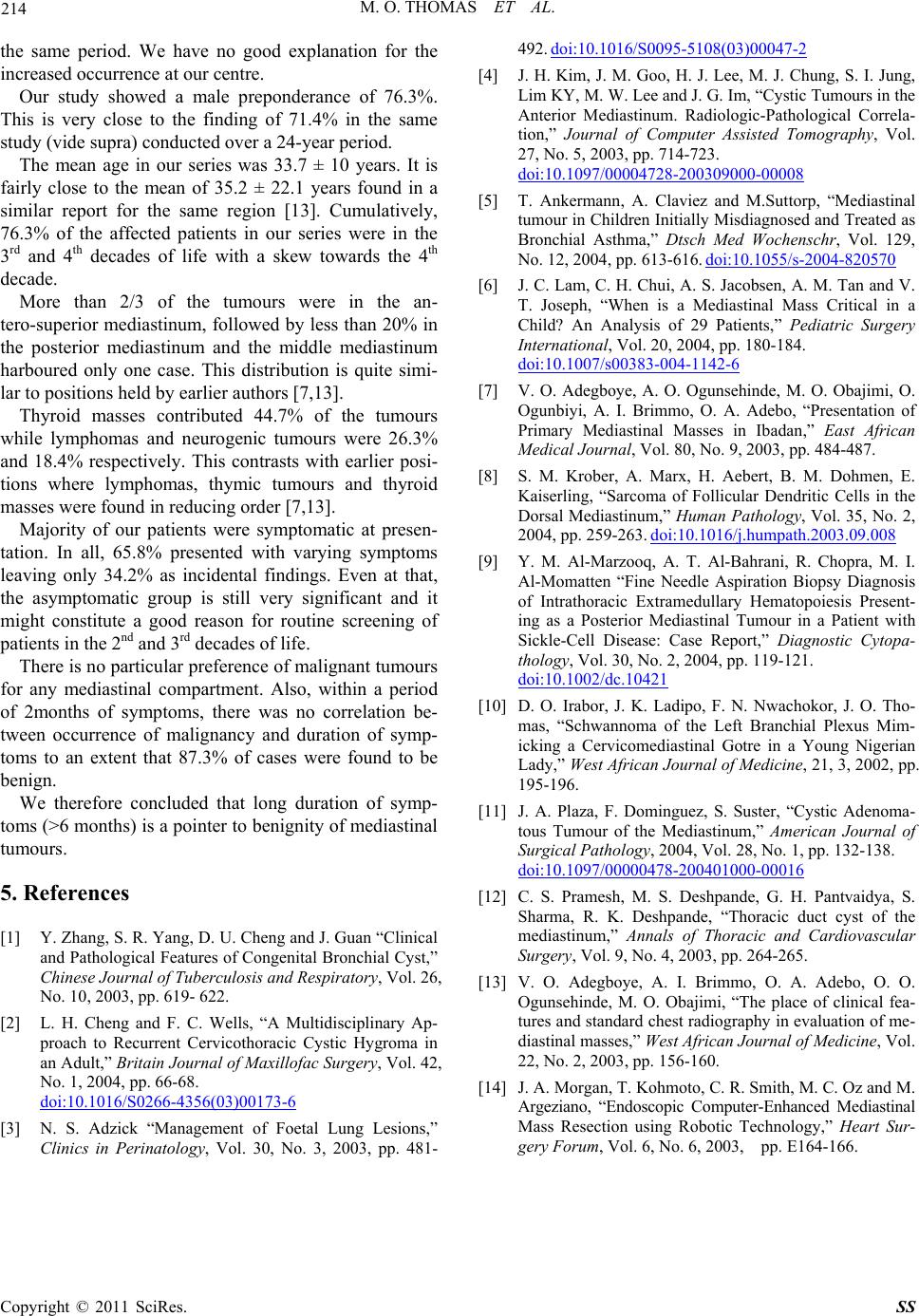
M. O. THOMAS ET AL.
Copyright © 2011 SciRes. SS
214
the same period. We have no good explanation for the
increased occurren c e at o u r centre.
Our study showed a male preponderance of 76.3%.
This is very close to the finding of 71.4% in the same
study (vide supra) conducted over a 24-year period.
The mean age in our series was 33.7 ± 10 years. It is
fairly close to the mean of 35.2 ± 22.1 years found in a
similar report for the same region [13]. Cumulatively,
76.3% of the affected patients in our series were in the
3rd and 4th decades of life with a skew towards the 4th
decade.
More than 2/3 of the tumours were in the an-
tero-superior mediastinum, followed by less than 20 % in
the posterior mediastinum and the middle mediastinum
harboured only one case. This distribution is quite simi-
lar to positions held by earlier authors [7,13].
Thyroid masses contributed 44.7% of the tumours
while lymphomas and neurogenic tumours were 26.3%
and 18.4% respectively. This contrasts with earlier posi-
tions where lymphomas, thymic tumours and thyroid
masses were found in reducing order [7,13].
Majority of our patients were symptomatic at presen-
tation. In all, 65.8% presented with varying symptoms
leaving only 34.2% as incidental findings. Even at that,
the asymptomatic group is still very significant and it
might constitute a good reason for routine screening of
patients in the 2nd and 3rd decades of life.
There is no particular preference of malignant tumours
for any mediastinal compartment. Also, within a period
of 2months of symptoms, there was no correlation be-
tween occurrence of malignancy and duration of symp-
toms to an extent that 87.3% of cases were found to be
benign.
We therefore concluded that long duration of symp-
toms (>6 months) is a pointer to benignity of mediastinal
tumours.
5. References
[1] Y. Zhang, S. R. Yang, D. U. Cheng and J. Guan “Clinical
and Pathological Features of Congenital Bronchial Cyst,”
Chinese Journal of Tuberculosis and Respiratory, Vol. 26,
No. 10, 2003, pp. 619- 622.
[2] L. H. Cheng and F. C. Wells, “A Multidisciplinary Ap-
proach to Recurrent Cervicothoracic Cystic Hygroma in
an Adult,” Britain Journal of Maxillofac Surgery, Vol. 42,
No. 1, 2004, pp. 66-68.
doi:10.1016/S0266-4356(03)00173-6
[3] N. S. Adzick “Management of Foetal Lung Lesions,”
Clinics in Perinatology, Vol. 30, No. 3, 2003, pp. 481-
492. doi:10.1016/S0095-5108(03)00047-2
[4] J. H. Kim, J. M. Goo, H. J. Lee, M. J. Chung, S. I. Jung,
Lim KY, M. W. Lee and J. G. Im, “Cystic Tumours in the
Anterior Mediastinum. Radiologic-Pathological Correla-
tion,” Journal of Computer Assisted Tomography, Vol.
27, No. 5, 2003, pp. 714-723.
doi:10.1097/00004728-200309000-00008
[5] T. Ankermann, A. Claviez and M.Suttorp, “Mediastinal
tumour in Children Initially Misdiagnosed and Treated as
Bronchial Asthma,” Dtsch Med Wochenschr, Vol. 129,
No. 12, 2004, pp. 613-616. doi:10.1055/s-2004-820570
[6] J. C. Lam, C. H. Chui, A. S. Jacobsen, A. M. Tan and V.
T. Joseph, “When is a Mediastinal Mass Critical in a
Child? An Analysis of 29 Patients,” Pediatric Surgery
International, Vol. 20, 2004, pp. 180-184.
doi:10.1007/s00383-004-1142-6
[7] V. O. Adegboye, A. O. Ogunsehinde, M. O. Obajimi, O.
Ogunbiyi, A. I. Brimmo, O. A. Adebo, “Presentation of
Primary Mediastinal Masses in Ibadan,” East African
Medical Journal, Vol. 80, No. 9, 2003, pp. 484-487.
[8] S. M. Krober, A. Marx, H. Aebert, B. M. Dohmen, E.
Kaiserling, “Sarcoma of Follicular Dendritic Cells in the
Dorsal Mediastinum,” Human Pathology, Vol. 35, No. 2,
2004, pp. 259-263. doi:10.1016/j.humpath.2003.09.008
[9] Y. M. Al-Marzooq, A. T. Al-Bahrani, R. Chopra, M. I.
Al-Momatten “Fine Needle Aspiration Biopsy Diagnosis
of Intrathoracic Extramedullary Hematopoiesis Present-
ing as a Posterior Mediastinal Tumour in a Patient with
Sickle-Cell Disease: Case Report,” Diagnostic Cytopa-
thology, Vol. 30, No. 2, 2004, pp. 119-121.
doi:10.1002/dc.10421
[10] D. O. Irabor, J. K. Ladipo, F. N. Nwachokor, J. O. Tho-
mas, “Schwannoma of the Left Branchial Plexus Mim-
icking a Cervicomediastinal Gotre in a Young Nigerian
Lady,” West African Journal of Medicine, 21, 3, 2002, pp.
195-196.
[11] J. A. Plaza, F. Dominguez, S. Suster, “Cystic Adenoma-
tous Tumour of the Mediastinum,” American Journal of
Surgical Patholo g y , 2004, Vol. 28, No. 1, pp. 132-138.
doi:10.1097/00000478-200401000-00016
[12] C. S. Pramesh, M. S. Deshpande, G. H. Pantvaidya, S.
Sharma, R. K. Deshpande, “Thoracic duct cyst of the
mediastinum,” Annals of Thoracic and Cardiovascular
Surgery, Vol. 9, No. 4, 2003, pp. 264-265.
[13] V. O. Adegboye, A. I. Brimmo, O. A. Adebo, O. O.
Ogunsehinde, M. O. Obajimi, “The place of clinical fea-
tures and standard chest radiography in evaluation of me-
diastinal masses,” West African Journal of Medicine, Vol.
22, No. 2, 2003, pp. 156-160.
[14] J. A. Morgan, T. Kohmoto, C. R. Smith, M. C. Oz and M.
Argeziano, “Endoscopic Computer-Enhanced Mediastinal
Mass Resection using Robotic Technology,” Heart Sur-
gery Forum, Vol. 6, No. 6, 2003, pp. E164-166.